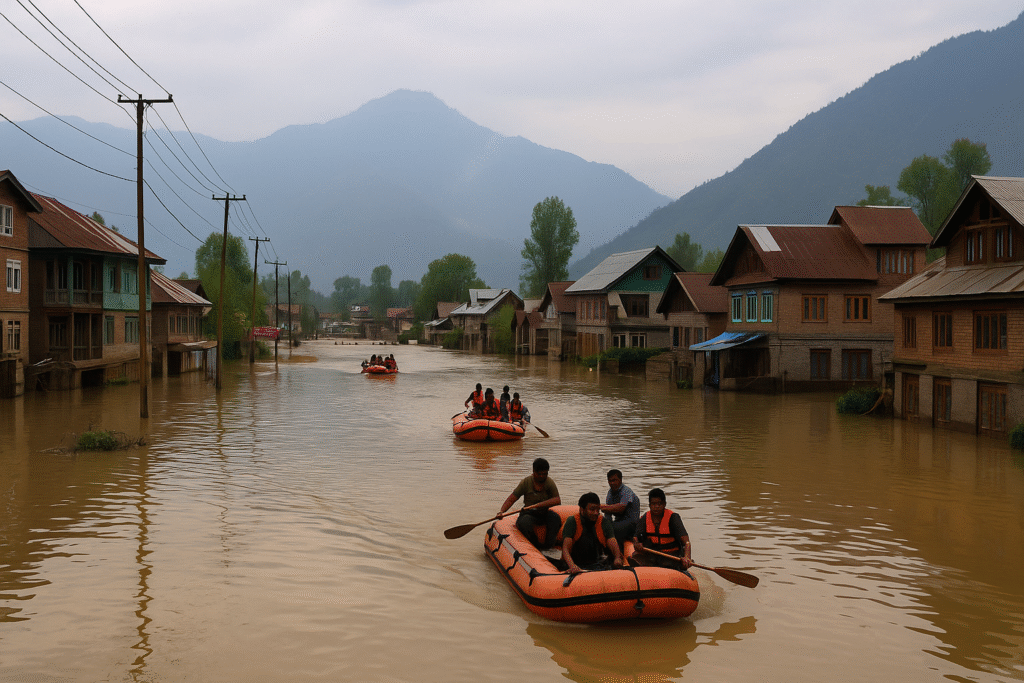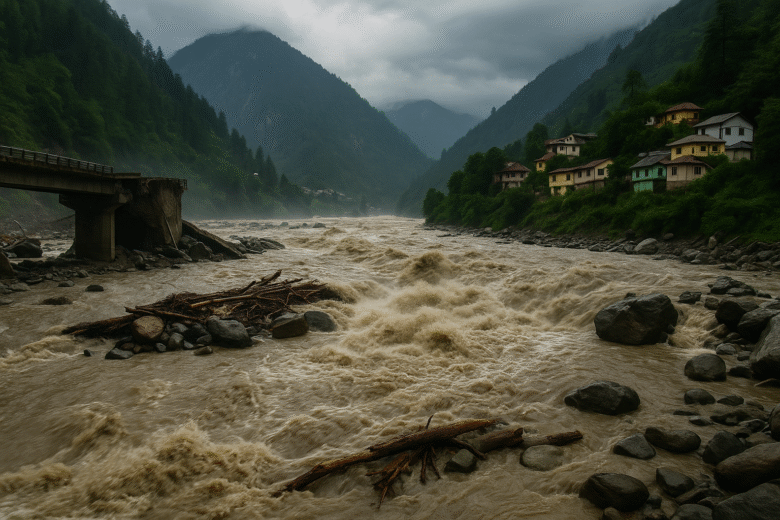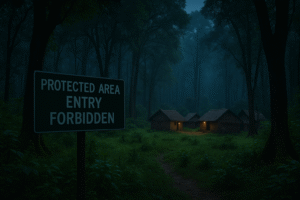Fun Fact: In some Himalayan valleys, the number of days of “extreme weather events” during the 2025 monsoon season reached 51 %—up from just 10.8 % three years ago.
“Floods, Landslides, and Climate Debt: Northern India’s New Normal” isn’t just a provocative headline—it’s the lived reality for people in the Himalayan states. As rain-soaked skies turn from blessing to threat and mountains rumble beneath shifting soils, the north is witnessing disasters that aren’t just natural—they are shaped by human decisions, climatic shifts and deferred debts.
Monsoon Patterns Gone Rogue
This monsoon, the mountains don’t behave. The India Meteorological Department (IMD) and other scientists documented that in 2025, large parts of northern India got extreme rain far beyond the long-period average.
In the western Himalayas, a surge of so-called “western disturbances”—systems that usually visit outside the monsoon—is now mingling with monsoon moisture, triggering cloudbursts and sudden floods.
That means waters rise fast, slopes collapse faster, and the terrain has less time to recover.
Case Study: Uttarakhand’s Flash Floods and Landslides
In early August 2025 the valley of Dharali in Uttarkashi district of Uttarakhand was swept by a torrent of debris, mud and water—a flash flood sparked by a cloudburst or glacial outburst.
Experts point out that warming temperatures are reducing night-time minimums, melting glaciers, reducing snow-cover and destabilising slopes. Add to that unplanned roads, hydro-projects built with scant regard to geology, and you get a disaster recipe.
The mountain isn’t just collapsing under rain—it’s collapsing under climate plus design failures.
Case Study: Kashmir’s Landslides and Floods
In Kishtwar district of the union territory of Jammu & Kashmir a cloudburst in August 2025 triggered a flash-flood and landslide event that washed away homes, pilgrims, infrastructure. At least 60 people died and over 200 were missing.
The same factors: steep slopes, heavy rain, poorly regulated construction, and glacier-fed rivers bursting their banks. It’s a stark reminder that even remote places are now in the risk zone.

Climate Debt: The Unpaid Tab
What is “climate debt”? Simply put: our past emissions and environmental neglect are now being paid for by people who often did the least to cause them. These Himalayan disasters are a form of debt repayment. While high-emitting sectors may have caused the warming, when a village in Uttarakhand is erased by a mudslide, the locals pay the price.
From 5 August in Uttarakhand to late August in Kashmir, the pattern is the same: climate stress + human pressure = death and disruption. And this is only going to get worse. Researchers note that about half of river basins once called “low risk” are now seeing frequent “wet hours” and run-off peaks.
Why It Doesn’t Have to Be This Way (But Often Is)
The frontline between disaster and safety is not purely nature—it’s policy, planning, governance, development. In Uttarakhand, the report on mountain development says the state must integrate climate risks into all infrastructure decisions.
Yet what do we see? Rising construction in eco-sensitive zones, hydropower projects in fragile catchments, settlements creeping into hazard zones. The climate risk is magnified when human systems act as if the mountain is immutable.
The message is: To reduce disasters you don’t just build stronger defences—you build smarter communities, smarter infrastructure and smarter respect for nature’s limits.
Everyday Lives, Everyday Shocks
Behind the numbers are human lives: farmers whose lands are buried under debris, trekkers stranded when a route collapses, villagers collecting water where the stream has shifted, children unable to attend school because a bridge washed out, families displaced into temporary shelters where cold meets damp.
One local in Kishtwar said: “We expected rain—we didn’t expect a cliff to fall on us.” Which reflects a troubling truth: these disasters aren’t always “acts of God” anymore. They are acts of a troubled climate meeting fragile development.
Conclusion: Turning the Tide Before It’s Too Late
“Floods, Landslides, and Climate Debt: Northern India’s New Normal” might sound like a headline for doom—but it’s also a call to wake up. The risk is real, the people are vulnerable, and the mountain is speaking.
If we wait for the next tragedy, we’ll pay again—this time in lives, assets and heritage. Instead, we can act: integrate climate into planning, respect mountain ecology, halt ill-placed development, invest in early warning systems, build resilient communities.
Because when the hills collapse and the rivers roar, we’ll ask: did we really try to listen? Or did we keep building as if nothing had changed? The time is now to pay our climate debt proactively—not when the bill comes due in loss and grief.
Author’s Note
One evening I stood below a mountain slope in Uttarakhand, watching grey clouds gather and thinking: this is nature and I am small. But then I thought: maybe nature doesn’t change as fast as we do. It’s us who have sped things up—our climate, our scars, our debt. Writing this blog matters to me because I want us to see that the mountain isn’t waiting for us to change—it already changed around us. Writing is not just telling you something—it’s reminding us both to look, listen and act.
G.C., Ecosociosphere contributor.
References and Further Reading
- Uttarakhand flood case-study: why India must integrate climate risks into mountain development
- Shifting monsoon patterns behind cloudbursts in Uttarakhand and Kashmir
- Flash floods threaten India’s “safe zones”: climate change is redrawing the risk map
- Himalayan states face multiple flood disasters in 2025 monsoon
- Why Uttarakhand is getting hit again & again: landslides, floods expose risks of unchecked development
- Monsoon 2025 anomaly: western disturbances intensify Himalayas disasters driven by warming




